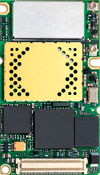

The new XT65 and XT75 wireless modules from Siemens are designed for every application that requires GSM/GPRS/EDGE communication combined with GPS tracking, and optimise the way in which the two technologies interact.
The XT65 and XT75 are in a better position to do this than other wireless modules as they are said to be the only cellular modules on the market to combine the two essential tracking technologies - GSM and GPS - operating simultaneously on a single board. Their quad-band GSM technology enables the application they are fitted into to transmit data from anywhere in the world and the state-of-the-art GPS receiver allows tracking with a sensitivity of -158 dBm.
The single-board solution enables developers to use a ready-made communication/tracking platform for their tracking applications, which can be programmed using the embedded Java platform. The Java platform allows the development of sophisticated M2M (machine to machine) applications and saves on additional cost as the modules are equipped with a processor and additional memory. The modules also include a variety of interfaces for connection to the application board on the one hand and to various sensors and actuators on the other. As the size of the modules has been reduced to a minimum, the main challenge facing designers of tracking devices is met. The integration of GSM and GPS functionality in this way provides developers a shorter design cycle than traditional solutions which keep the technologies separate.
The XT65 and XT75 can be used in a variety of applications such as personal locating devices, for fleet management, goods tracking or for navigation purposes in vehicles. The latter can particularly benefit as navigation systems can be enhanced with additional features such as Internet services for back-seat passengers, updates for chip cards and information on local points of interest.
The time taken to pinpoint a person's or vehicle's position using GPS is often critical, especially in navigation systems. This, combined with the fact that conventional GPS has difficulty providing reliable positions in environments surrounded by tall buildings or under heavy cover, makes designing GPS tracking products very challenging. To address this, the XT65/75 supports assisted GPS (A-GPS). With the use of an Assistance Server, a location can be obtained in the harshest of environments and the time taken to obtain a 'first-fix' after switching the GPS receiver on is reduced dramatically.
The XT65 module supports GSM/GPRS and GPS and is ideally suited for applications that do not require transmission of high volumes of data. For applications that are data-intensive, the XT75 with its support of EDGE is the perfect solution with data rates up to 236,8 Kbps. Although these modules are developed specifically for tracking applications, they still support all the standard functionality expected of a GSM modem such as voice, SMS and CSD support. And with the embedded Java platform, designers are provided the ability to update their application code 'over-the-air', enabling products in the field to be updated from anywhere in the world.
For more information contact Siemens, +27 (0)11 652 2581.

© Technews Publishing (Pty) Ltd | All Rights Reserved